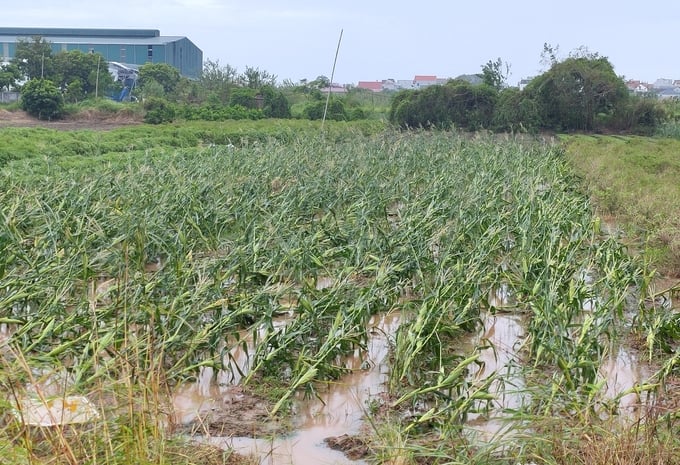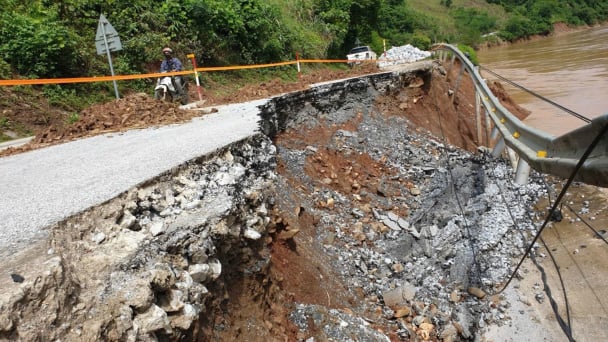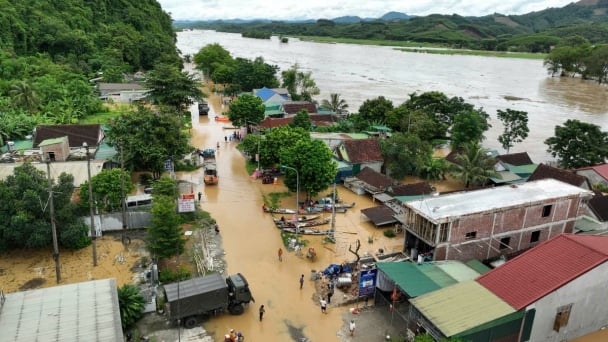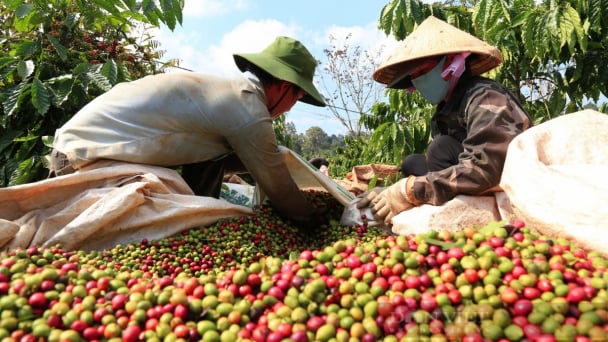July 31, 2025 | 12:34 GMT +7
July 31, 2025 | 12:34 GMT +7
Hotline: 0913.378.918
July 31, 2025 | 12:34 GMT +7
Hotline: 0913.378.918

Le Quoc Thanh (left), General Director of the National Agricultural Extension Center, providing instructions on environmental management after storms and floods to Thai Nguyen residents. Photo: Pham Hieu.
Typhoon No. 3 and subsequent floods have caused severe damage to the northern provinces of Vietnam. In response, the National Agricultural Extension Center under the Ministry of Agriculture and Rural Development has issued detailed guidelines for local governments and agricultural extension systems in the northern provinces. Accordingly, these parties must focus on performing post-disaster recovery efforts for crop, livestock, and aquaculture production. They must also assess the damage to propose appropriate recovery measures.
According to Hoang Van Hong, Deputy Director of the National Agricultural Extension Center, the agency has instructed all local agricultural extension systems to develop recovery plans for storm and flood damage and support farmers in restoring production.
"Several local vegetable fields are flooded, and we have urged farmers to harvest their fields. When the water recedes, they need to replant vegetables with a short production cycle, which can be harvested in 40 to 45 days to meet market demand. Additionally, short-term crops such as corn and soybeans can be sown for seed production," suggested Deputy Director Hoang Van Hong.
The National Agricultural Extension Center has also organized training sessions for farmers on cultivating short-term soybean varieties, biomass corn, and winter vegetables. On the other hand, the agency has also encouraged businesses and donors to provide farmers with seeds, particularly vegetable, corn, and soybean varieties, as well as fertilizers and other agricultural supplies.

Corn fields in Hung Yen suffered extensive damage after Typhoon No. 3. Photo: Pham Hieu.
According to Nguyen Quy Duong, Deputy Director of the Department of Plant Protection under the Ministry of Agriculture and Rural Development, in response to reports concerning Typhoon No. 3, the department quickly instructed its affiliated agencies to closely coordinate with local governments, with a focus on areas forecast to be affected by the typhoon, such as Quang Ninh, Hai Phong, Thai Binh, Nam Dinh, and other Red River Delta provinces, to prepare for the heavy rains and flooding.
"Before the typhoon made landfall, local authorities performed on-field inspections and collaborated with local authorities to organize pest and disease control measures, particularly against stem borers and leaf rollers," Deputy Director Duong reported.
In addition, the Department of Plant Protection instructed its local branches to deploy teams and directly assess the damage. This initiative allowed for accurate predictions of potential pest outbreaks, thereby enabling timely and effective interventions to protect rice, crops, and fruit trees in affected areas.
According to the Deputy Director, fertilizers and plant protection chemicals are currently the two most crucial agricultural supplies for restoring crop health after floods.
"As a result, we have assigned technical officers to maintain a strict management system, guaranteeing sufficient quantity, quality, and reasonable prices for fertilizers, plant protection chemicals, and other agricultural supplies to meet the practical needs of local residents," emphasized Deputy Director Nguyen Quy Duong.
According to the Ministry of Agriculture and Rural Development, the recent Typhoon No. 3 has severely damaged rice production areas in the northern provinces of Vietnam.
At present, multiple rice fields in these provinces are entering the crucial stages of flowering and grain development. Notably, the local farmers are preparing for early harvest and winter crop production. However, numerous fields have been flattened and waterlogged due to the typhoon.
Deputy Director Hoang Van Hong emphasized that farmers must urgently drain excess water from the fields to protect the health of the rice crops.
"For rice plants that began grain formation within the last three to five days, prolonged flooding will cause irreparable damage. As a result, farmers must quickly drain excess water from the fields. Then, they should prop up rice stalks that have flowered and begun to form grains to allow for photosynthesis and continued growth," Deputy Director Hoang Van Hong explained.
For rice plants that have recently flowered without forming grains, farmers should position the stalks at an angle of 70 to 80 degrees to facilitate photosynthesis after draining water from the fields. For rice plants that are currently in the booting stage, farmers must also drain the water and protect the leaves, as they are vital for photosynthesis and grain formation.
Translated by Nguyen Hai Long

(VAN) According to Standing Office of the Steering Committee for Disaster Prevention, Search and Rescue, and Civil Defense of Nghe An, the province has incurred flood-related damages totaling nearly 3.4 trillion VND.

(VAN) According to the World Meteorological Organization (WMO), Vietnam is a suitable location for the establishment of the Flash Flood Warning Center and the Southeast Asia Hazardous Weather Forecasting Center.

(VAN) The Management Board of Ninh Hoa-Van Ninh Protection Forest is inviting qualified and enthusiastic organizations and individuals to participate in leasing forest environments for eco-tourism development.
![Conservation at Yok Don National Park: [2] Efforts to preserve biodiversity](https://t.ex-cdn.com/nongnghiepmoitruong.vn/608w/files/chiqk/2025/07/30/3244-3-phoi-hop-tuan-tra-cung-nguoi-dan-bvrjpg-nongnghiep-093235.jpg)
(VAN) Yok Don National Park is managing nearly 111,000 hectares of natural forest, including over 2,563 hectares of rich forest and nearly 34,220 hectares of medium-density forest.
![Opening the hairy crab farming industry: [2] Reasons behind frequent failures](https://t.ex-cdn.com/nongnghiepmoitruong.vn/608w/files/tuongdt/2025/07/25/5743-dsc_6555_1-215036_670.jpg)
(VAN) From his experience raising ca ra (hairy crabs) in Tu Ky (Hai Phong), and through learning farming technology in China, Mr. Van has come to understand many crucial lessons.
![Conservation in Yok Don National Park [1] A globally important ecoregion](https://t.ex-cdn.com/nongnghiepmoitruong.vn/608w/files/content/2025/07/30/conservation-in-yok-don-national-park-1-a-globally-important-ecoregion-092358_235-142344.jpg)
(VAN) Yok Don National Park is home to 565 species of useful plants and 648 species of vertebrates, 165 species of these classified as endangered and in need of conservation.

(VAN) The agriculture and environment sector has set an export target of USD 70 billion for 2025 while sustaining growth, expanding markets, increasing value, and implementing bold reforms.